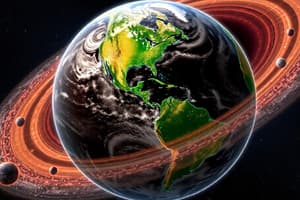Podcast
Questions and Answers
Does the moon make Earth a livable planet?
Does the moon make Earth a livable planet?
True (A)
What are the factors that make Earth habitable?
What are the factors that make Earth habitable?
Temperature, atmosphere, nutrients, energy
What is a system in the context of Earth science?
What is a system in the context of Earth science?
An interconnected set of components that function to create an outcome.
All systems on Earth are classified as open systems.
All systems on Earth are classified as open systems.
What is a closed system?
What is a closed system?
What are the four systems of the Earth?
What are the four systems of the Earth?
Which of the following are characteristics of minerals? (Select all that apply)
Which of the following are characteristics of minerals? (Select all that apply)
What are rocks considered to be in the context of minerals?
What are rocks considered to be in the context of minerals?
What does the term 'luster' refer to in minerals?
What does the term 'luster' refer to in minerals?
Which mineral is the hardest according to Mohs Scale?
Which mineral is the hardest according to Mohs Scale?
All minerals exhibit cleavage.
All minerals exhibit cleavage.
Rocks are aggregates of one or more minerals.
Rocks are aggregates of one or more minerals.
Most minerals are economically important.
Most minerals are economically important.
The hardest naturally occurring mineral is corundum.
The hardest naturally occurring mineral is corundum.
The Mohs scale is used to describe the mineral property of a diamond.
The Mohs scale is used to describe the mineral property of a diamond.
Solid ice is a mineral.
Solid ice is a mineral.
Which of the following is a silicate mineral?
Which of the following is a silicate mineral?
What is specific gravity in relation to minerals?
What is specific gravity in relation to minerals?
Flashcards
Moon's role
Moon's role
Stabilizes Earth's axial tilt, contributing to climate stability and habitable environment.
Habitability Factors
Habitability Factors
Temperature, atmosphere, nutrients, and energy availability.
Earth Systems
Earth Systems
Interconnected components functioning together to produce outcomes.
Closed System
Closed System
Signup and view all the flashcards
Biosphere
Biosphere
Signup and view all the flashcards
Hydrosphere
Hydrosphere
Signup and view all the flashcards
Atmosphere
Atmosphere
Signup and view all the flashcards
Geosphere
Geosphere
Signup and view all the flashcards
Mineral
Mineral
Signup and view all the flashcards
Rocks
Rocks
Signup and view all the flashcards
Crystal Form
Crystal Form
Signup and view all the flashcards
Luster
Luster
Signup and view all the flashcards
Streak
Streak
Signup and view all the flashcards
Hardness
Hardness
Signup and view all the flashcards
Cleavage
Cleavage
Signup and view all the flashcards
Fracture
Fracture
Signup and view all the flashcards
Specific Gravity
Specific Gravity
Signup and view all the flashcards
Most Abundant Elements
Most Abundant Elements
Signup and view all the flashcards
Study Notes
Moon and Earth
- The moon stabilizes Earth's axial tilt, contributing to climate stability.
- Its gravitational pull affects Earth's tides and helps maintain a habitable environment.
Factors for Habitability
- Key factors include temperature, atmosphere, nutrients, and energy availability.
Earth Systems
- Systems are interconnected components functioning together to produce outcomes.
- Earth's systems are classified as open systems, though the Earth system as a whole is a closed system with limited matter exchange.
Closed System Definition
- A closed system exchanges only heat/energy, not matter.
- Earth's four main systems: biosphere, hydrosphere, atmosphere, geosphere.
Earth’s Four Systems
- Biosphere: Encompasses all living organisms.
- Hydrosphere: Includes all forms of water, such as rivers, lakes, and ice.
- Atmosphere: A mixture of gases surrounding Earth, functioning as a protective blanket.
- Geosphere: Consists of geological structures like mountains and valleys.
Mineral Characteristics
- Minerals are naturally occurring, solid, inorganic, crystalline substances with a defined chemical composition.
Rocks Composition
- Rocks are aggregates of one or more minerals, forming distinct geological materials.
Physical Properties of Minerals
- Crystal Form: Reflects internal atomic arrangement and determines the mineral's appearance.
- Luster: Indicates how light interacts with a mineral's surface; can be shiny or dull.
- Color: Often unreliable for identification due to possible color variations from impurities.
- Streak: The color of a mineral in powdered form is more reliable than its visible color.
- Hardness: Measured using Mohs Scale; talc is the softest while diamond is the hardest.
- Cleavage: Describes minerals that break along smooth surfaces.
- Fracture: Minerals that break irregularly without smooth cleavage surfaces.
- Specific Gravity: The ratio of a mineral's weight compared to an equal volume of water, usually between 2.6 and 3.4.
Abundant Elements in Earth's Crust
- The most prevalent elements: Oxygen, Silicon, Aluminum, Iron, Calcium, Sodium, Potassium, Magnesium, which are foundational to numerous minerals.
True-False Statements
- False: Not all minerals exhibit cleavage.
- True: Rocks consist of one or more minerals.
- True: Most minerals have economic significance.
- True: Most minerals have higher specific gravity than water.
- True: Micas display sheet-type cleavage.
- True: Minerals can consist of a single element.
- False: Not all known minerals exceed 3,900.
- False: Corundum is not the hardest, diamond is.
- True: The Mohs scale describes hardness.
- False: Solid ice is classified as a mineral.
Other Mineral Properties
- Magnetism: Some minerals, like magnetite, are magnetically attractive.
- Taste, Odor, Feel: Certain minerals are identifiable by sensory properties.
- Reactivity with Acid: Assists in identifying specific minerals, such as carbonates.
- Density: Measures mass relative to volume, assisting in mineral identification.
Mineral Classification
- Silicate Minerals: Most abundant, containing silicon and oxygen.
- Non-Silicate Minerals: Constitute only about 5% of the Earth's crust.
Studying That Suits You
Use AI to generate personalized quizzes and flashcards to suit your learning preferences.



